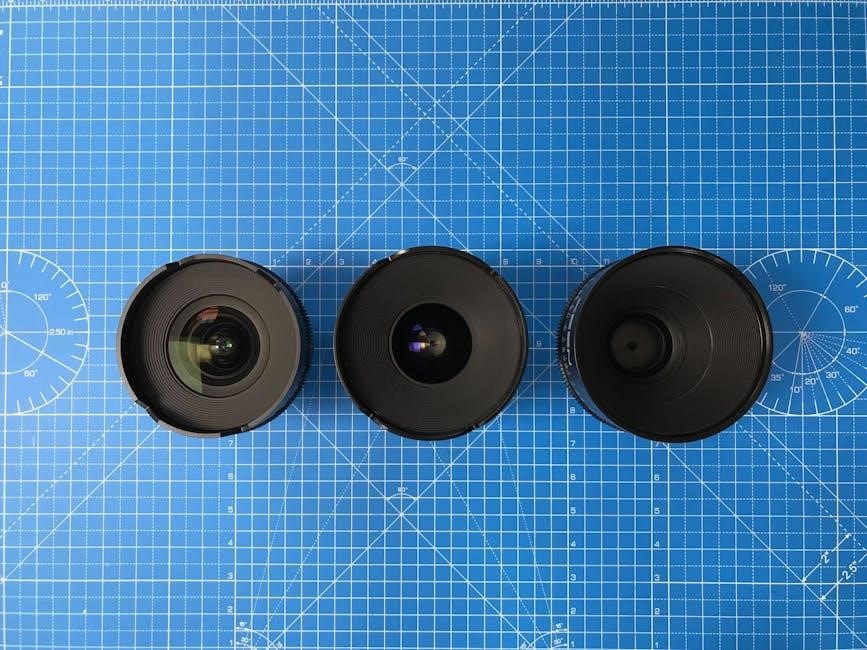Cadence IC design tools are industry-leading solutions for creating and analyzing integrated circuits, offering comprehensive tutorials to master the design flow from schematic capture to final layout.
Overview of Cadence and Its Importance in IC Design
Cadence is a pioneer in the EDA (Electronic Design Automation) industry, providing cutting-edge tools for integrated circuit (IC) design. Its software is essential for creating, simulating, and verifying complex analog, digital, and mixed-signal designs. Cadence tools are widely used in the semiconductor industry due to their accuracy, efficiency, and scalability. They enable engineers to tackle challenging design requirements, ensuring compliance with design rules and delivering high-performance outcomes. With a strong focus on innovation, Cadence supports the development of modern electronics, from simple circuits to advanced AI-boosted designs, making it indispensable for IC designers worldwide. Its tutorials and resources empower users to master design flows effectively.
Getting Started with Cadence
To begin, install Cadence tools and load the appropriate design kit. Follow tutorials to build a simple circuit, simulate it, and analyze results, ensuring a solid foundation.
Installation and Setup of Cadence Tools
To install Cadence tools, ensure your system meets the required specifications, such as sufficient disk space and compatible operating system versions. Download the software from the official Cadence website or through your institution’s license portal. Follow the installation wizard to complete the setup. After installation, configure your environment by setting the necessary variables and paths. Load the appropriate design kit to access specific process technologies. Familiarize yourself with the interface by exploring menus and shortcuts. Finally, verify the setup by running a simple tutorial or example design to ensure everything functions correctly. This step is crucial for a smooth design experience.

Core Cadence Tools for IC Design
Cadence Virtuoso, Spectre, and Innovus are essential tools, enabling schematic capture, simulation, and layout implementation. These tools streamline the IC design process, ensuring accuracy and efficiency.
Cadence Virtuoso: Schematic Capture and Simulation
Cadence Virtuoso is a powerful tool for schematic capture and simulation, enabling designers to create and analyze analog and mixed-signal circuits. Its intuitive interface allows users to design schematics, simulate behavior, and verify performance. Virtuoso supports advanced simulation techniques, including DC, AC, and transient analysis. The tool also integrates seamlessly with other Cadence tools, ensuring a streamlined design flow. With features like Find by Name, users can quickly locate components and nets, enhancing productivity. Tutorials and documentation are available to help users master Virtuoso, making it an essential platform for modern IC design workflows.
Layout Design with Cadence
Cadence tools enable precise layout design, allowing users to create and edit layouts efficiently. Key features include LVS checks to ensure schematic and layout consistency, streamlining the design process.
Creating and Editing Layouts, LVS (Layout vs. Schematic) Checks
Cadence offers powerful tools for creating and editing layouts, ensuring precise transistor placement and connectivity. The layout editor provides a user-friendly interface for designing ICs, with features like grid snapping and layer management. After designing, LVS checks are performed to verify that the layout matches the schematic, ensuring design integrity. This step is critical for identifying mismatches that could lead to fabrication errors. By following best practices and leveraging Cadence’s built-in validation tools, designers can efficiently create accurate layouts and maintain consistency between schematic and physical designs. Regular LVS checks streamline the design process and reduce errors.
Waveform Viewer and Simulation Results
The waveform viewer in Cadence tools displays simulation results, allowing designers to analyze signal behavior and timing. It provides a user-friendly interface for measuring and comparing waveforms.
Analyzing and Interpreting Simulation Data
Analyzing simulation data is crucial for verifying circuit performance. Cadence tools provide a waveform viewer to display and interpret simulation results. Designers can use measurement markers to extract precise values, analyze timing delays, and compare signals. The viewer supports zoom and pan for detailed inspection. Simulation data interpretation involves checking nodal voltages, current flows, and power consumption. This step ensures compliance with design specifications and identifies potential issues. Tutorials often emphasize how to debug circuits by analyzing waveforms. Proper interpretation enables designers to optimize performance and troubleshoot issues effectively. This skill is essential for achieving accurate and reliable IC designs.

Design Rule Checking (DRC)
Design Rule Checking ensures compliance with fabrication standards, identifying violations to maintain design integrity and manufacturability, and avoid potential fabrication issues.
Running DRC and Understanding Violations
Running DRC involves executing the design rule checking tool to ensure compliance with fabrication standards. The tool scans the layout for violations, such as spacing, width, or overlap issues. Each violation is flagged, allowing designers to address problems before fabrication. Understanding violations is critical to maintaining design integrity and manufacturability. The DRC tool provides detailed reports, highlighting specific rule breaches and their locations. By systematically reviewing and correcting these issues, designers can ensure their IC meets foundry requirements and functions as intended. This step is essential for achieving a successful and error-free design sign-off.
Cadence offers advanced features like parameter extraction and Monte Carlo analysis, enabling sophisticated design exploration and optimization to enhance circuit performance and reliability.

Advanced Features in Cadence
Parameter Extraction and Monte Carlo Analysis
Parameter extraction and Monte Carlo analysis are advanced features in Cadence that enable detailed design exploration and optimization. Parameter extraction allows designers to accurately model circuit behavior by deriving key parameters from simulations. Monte Carlo analysis, on the other hand, simulates variations in manufacturing processes to assess yield and reliability. These tools are essential for analyzing how process variations impact circuit performance, enabling designers to identify potential weaknesses and optimize designs for robustness. By integrating these analyses into the design workflow, engineers can ensure higher performance, reliability, and manufacturability of their IC designs.
Search and Navigation in Cadence
Cadence provides robust search and navigation tools to efficiently locate cells, components, and design elements. Users can quickly find specific cells by name or pattern, streamlining the design workflow.
Using Search Tools to Find Cells and Components
Cadence offers advanced search functionalities to locate cells and components efficiently. Users can employ the Find by Name feature to quickly identify specific cells by their names or patterns. Additionally, the Search toolbar allows filtering by multiple criteria, such as design hierarchy or cell properties. This simplifies navigation through complex designs and accelerates the identification of required elements. Regular expressions can also be utilized to refine search results, ensuring precise and rapid access to desired components within large libraries or designs. These tools significantly enhance productivity in managing intricate IC layouts.

Real-World Applications of Cadence
Cadence tools are widely used in designing analog and mixed-signal ICs, with case studies showcasing their application in advanced chip architectures and CMOS technologies across industries.
Case Studies in Analog and Mixed-Signal Design
Cadence tools have been instrumental in designing complex analog and mixed-signal ICs, such as a 2-stage CMOS OP-Amp with a differential amplifier and common-source stage. These case studies highlight how Cadence enables precise schematic capture, simulation, and layout design. For instance, users have successfully implemented lumped parameter extractions and Monte Carlo analyses to optimize circuit performance. Real-world applications include co-optimizing CMOS technologies and disruptive chip architectures, leveraging AI-boosted design methodologies. These examples demonstrate Cadence’s versatility in addressing challenges like noise reduction, power optimization, and design rule compliance, making it a cornerstone for modern IC development.
Additional Resources and Tutorials
Cadence offers extensive tutorials, videos, and documentation to enhance learning. Resources include a Google Doc with short keys and a video tutorial for a Junior Electronics Course. Lessons on OrCAD Capture and part library creation are also available.
Recommended Tutorials and Documentation for Cadence
Cadence provides comprehensive tutorials and documentation to help users master IC design tools. A popular resource is the Cadence Short Keys document, offering quick shortcuts. Video tutorials, such as the Junior Year Electronics Course at WSU, guide students through building designs. Lessons on OrCAD Capture, part libraries, and homogeneous parts are also available. These resources, along with detailed manuals and user forums, ensure designers gain practical insights and troubleshooting tips for analog and mixed-signal design.
